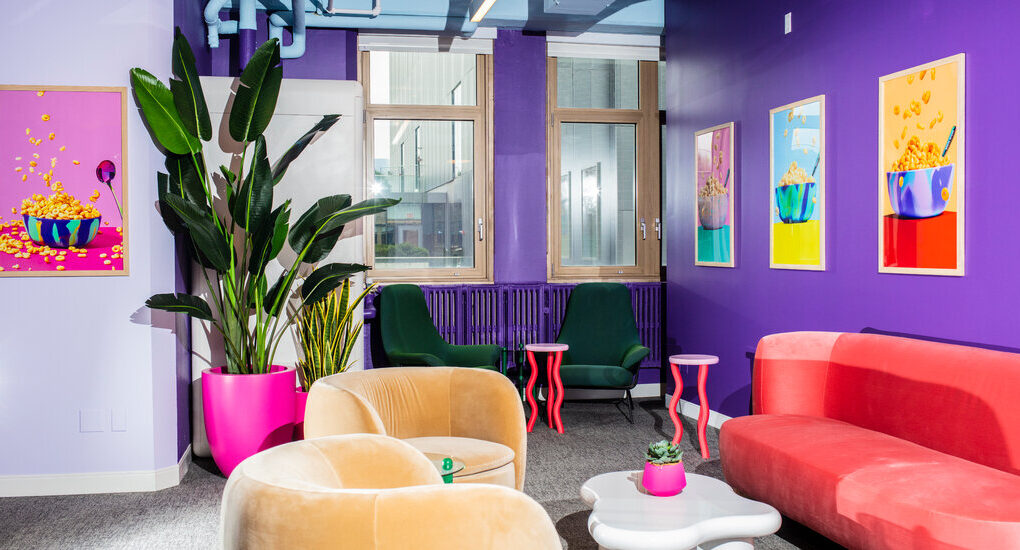Times Insider explains who we are and what we do and delivers behind-the-scenes insights into how our journalism comes together.
Perhaps you’ve seen them on Instagram: offices that look a whole lot cooler than yours. There are soundproof phone booths. Winged armchairs. Bookshelves stacked with strategically placed art books and old copies of The New Yorker.
They evoke a trending workplace style that the New York Times reporters Emma Goldberg and Anna Kodé have anointed the Envy Office. As they write in their article, companies are hoping Instagrammable office design will lure workers away from their couches and back into the workplace — to do their jobs on the velvet, and dog-friendly, couches there instead.
The Envy Office trades both the cubicle farms found in traditional workplaces and the climbing walls of Silicon Valley tech campuses for upholstered chairs and faux fiddle leaf figs, nestled in cozy corner nooks. But it’s not just an aesthetic: The design also prioritizes flexibility while reflecting a company’s brand. And some employers are hoping their younger staff members will share their trendy workplaces on social media.
Ms. Kodé and Ms. Goldberg began reporting in August, visiting offices in New York City. But the style trend is spreading across the country: Gensler, one of the largest architecture firms in the world, said it was increasingly getting requests to build office spaces with banquettes and library nooks.
In addition to their article, Ms. Kodé and Ms. Goldberg have also developed a quiz that helps readers discover their dream office setup. (Their responses pegged them both as Sofa Sophisticates, or those who enjoy working in tastefully designed spaces that facilitate socializing.)
In an interview, they share more about their reporting — and why they love working in The Times’s more traditional office, which was recently updated with some Envy Office flair. This conversation has been edited.
Anna, you cover real estate, and Emma, you’re on the future-of-work beat. What brought you together for this article?
EMMA GOLDBERG Anna and I had this long-running dream that we would find something to team up on. We’re similarly always looking for whimsical, creative or just fun avenues into what can be drier topics. When we spotted this one, we felt like it was a natural intersection of what we both cover.
ANNA KODÉ It’s clearly tied to Emma’s beat. And then it had this distinct angle of design and social media, which I’ve done a lot of reporting on. The overlap was just there.
How did you first learn about this type of design?
GOLDBERG I go to so many offices as part of reporting for my beat, and something I have noticed everywhere in recent months was the move toward offices looking like something between living rooms and hotel lobbies. Instead of the tech-bro campuses of the mid-2000s, workplaces were starting to look more trendy, sophisticated and hospitality-adjacent.
One of my favorite books, “Cubed” by Nikil Saval, is about the history of the cubicle. There has been this shift from cubicles to open floor plans to tech campuses. The questions Anna and I first discussed were: What’s the next phase of office design? What comes after the tech campus?
The Envy Office looks less masculine. It’s sophisticated and communal, but without some of the frills that the tech campus is known for. I didn’t see any nap pods.
KODÉ There is an element that’s definitely more tasteful, and there is a feminine design sensibility, particularly with one of the firms we have focused on, Roarke, which designed the Wing, the women’s social club that is now closed. I do think there are still some elements of “frill.” A lot of the responses to the story were: We don’t need Instagrammable furniture. We need better benefits.
Do these workplaces feed into a better office culture or boost productivity?
KODÉ I think it’s dependent on the type of person and work, but design does have a major effect on our interactions and how we go about our daily lives. Everything from the way a hallway is designed to the inclusion of plants can shape people’s behaviors and emotions in any space.
GOLDBERG One of the ideas we wanted to explore was that the design of an office was always baking in certain ideas about how a company wanted that space to operate. For example, some of the historians we spoke with talked about how one of the things that cubicles have done is communicate a sense of hierarchy. With every phase of office design, there have always been higher-level ideas that companies are trying to communicate.
A big part of what an Envy Office does is reflect the brand or the identity of a company. For example, when we toured the cereal brand Magic Spoon, something the designers kept emphasizing is that they wanted the space to feel like a cereal box. They wanted to capture the whimsy of their brand. I think what companies are hoping is that when people walk into an office space, they see the story that the brand is trying to tell.
What was something that you didn’t expect?
GOLDBERG One thing I was surprised by was the idea that companies are actively thinking about how their workers are going to project the image of the brand on their own social media channels, because we hear a lot more about companies struggling to rein in the ways that their employees use social media.
The Times’s newsroom has an open layout and bright red walls. Are you inspired by it?
KODÉ I love our building. I love Renzo Piano, its architect. I am a little bit of a nerd about it. The interior design has been changing. The Times recently added some of those library-nook spaces that we wrote about.
GOLDBERG I love our office, and I feel like I romanticize it too. Similarly to the companies we covered that wanted their brands to be represented in the design of their offices, so much of what I love about The Times is wrapped up in walking into this space and seeing colleagues doing their work.
I love the slightly chaotic energy of the newsroom, and what it represents about the excitement of the people in it and the history of the place.



